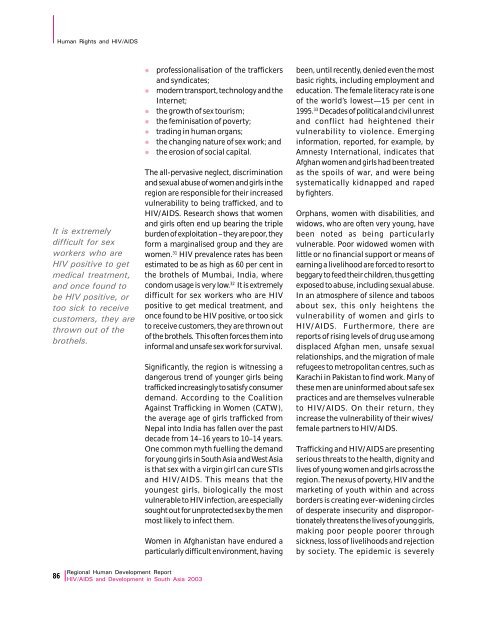Download Report - UNDP Asia-Pacific Regional Centre - United ...
Download Report - UNDP Asia-Pacific Regional Centre - United ...
Download Report - UNDP Asia-Pacific Regional Centre - United ...
Create successful ePaper yourself
Turn your PDF publications into a flip-book with our unique Google optimized e-Paper software.
Human Rights and HIV/AIDSIt is extremelydifficult for sexworkers who areHIV positive to getmedical treatment,and once found tobe HIV positive, ortoo sick to receivecustomers, they arethrown out of thebrothels.lllllllprofessionalisation of the traffickersand syndicates;modern transport, technology and theInternet;the growth of sex tourism;the feminisation of poverty;trading in human organs;the changing nature of sex work; andthe erosion of social capital.The all-pervasive neglect, discriminationand sexual abuse of women and girls in theregion are responsible for their increasedvulnerability to being trafficked, and toHIV/AIDS. Research shows that womenand girls often end up bearing the tripleburden of exploitation – they are poor, theyform a marginalised group and they arewomen. 31 HIV prevalence rates has beenestimated to be as high as 60 per cent inthe brothels of Mumbai, India, wherecondom usage is very low. 32 It is extremelydifficult for sex workers who are HIVpositive to get medical treatment, andonce found to be HIV positive, or too sickto receive customers, they are thrown outof the brothels. This often forces them intoinformal and unsafe sex work for survival.Significantly, the region is witnessing adangerous trend of younger girls beingtrafficked increasingly to satisfy consumerdemand. According to the CoalitionAgainst Trafficking in Women (CATW),the average age of girls trafficked fromNepal into India has fallen over the pastdecade from 14–16 years to 10–14 years.One common myth fuelling the demandfor young girls in South <strong>Asia</strong> and West <strong>Asia</strong>is that sex with a virgin girl can cure STIsand HIV/AIDS. This means that theyoungest girls, biologically the mostvulnerable to HIV infection, are especiallysought out for unprotected sex by the menmost likely to infect them.Women in Afghanistan have endured aparticularly difficult environment, havingbeen, until recently, denied even the mostbasic rights, including employment andeducation. The female literacy rate is oneof the world’s lowest—15 per cent in1995. 33 Decades of political and civil unrestand conflict had heightened theirvulnerability to violence. Emerginginformation, reported, for example, byAmnesty International, indicates thatAfghan women and girls had been treatedas the spoils of war, and were beingsystematically kidnapped and rapedby fighters.Orphans, women with disabilities, andwidows, who are often very young, havebeen noted as being particularlyvulnerable. Poor widowed women withlittle or no financial support or means ofearning a livelihood are forced to resort tobeggary to feed their children, thus gettingexposed to abuse, including sexual abuse.In an atmosphere of silence and taboosabout sex, this only heightens thevulnerability of women and girls toHIV/AIDS. Furthermore, there arereports of rising levels of drug use amongdisplaced Afghan men, unsafe sexualrelationships, and the migration of malerefugees to metropolitan centres, such asKarachi in Pakistan to find work. Many ofthese men are uninformed about safe sexpractices and are themselves vulnerableto HIV/AIDS. On their return, theyincrease the vulnerability of their wives/female partners to HIV/AIDS.Trafficking and HIV/AIDS are presentingserious threats to the health, dignity andlives of young women and girls across theregion. The nexus of poverty, HIV and themarketing of youth within and acrossborders is creating ever-widening circlesof desperate insecurity and disproportionatelythreatens the lives of young girls,making poor people poorer throughsickness, loss of livelihoods and rejectionby society. The epidemic is severely86<strong>Regional</strong> Human Development <strong>Report</strong>HIV/AIDS and Development in South <strong>Asia</strong> 2003
















